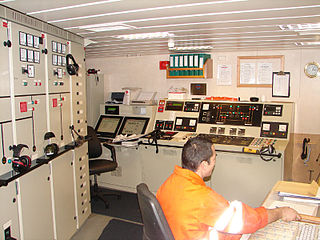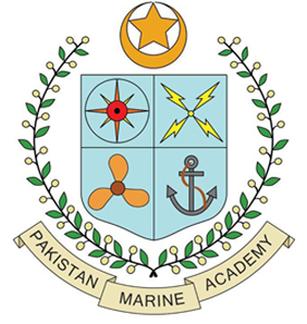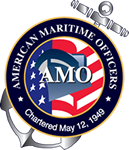This article needs additional citations for verification .(October 2008) |
A fourth engineer or third assistant engineer is the most Junior engine officer in the engine department of a merchant vessel.
This article needs additional citations for verification .(October 2008) |
A fourth engineer or third assistant engineer is the most Junior engine officer in the engine department of a merchant vessel.
| General | |
|---|---|
| Other names | Third assistant engineer |
| Department | Engine department |
| Reports to | Chief engineer, second engineer, third engineer |
| Licensed | Yes Merchant Mariner Credential |
| Duties | Daily maintenance and operation in the engine department |
| Requirements | Completed 4 year course at academy or complete exams as unlicensed engineer with required sea time |
| Watchstanding | |
| Watchstander | Depends on manned or unmanned engine room, may be called in to do security watches when in port |
| Watch (at sea) | Engine room on board ships (2000-0000, 0000-0400, 0400-0800, 0800-1200, 1200-1600, 1600-1800, 1800-2000) |
| Watch (in port) | Engine room, security checkpoint (1600-2400) |
A third assistant engineer’s license is by a Maritime Administration in accordance with the International Convention on the Standards and Training of Watchkeepers that allows the recipient to work on board any vessel up to the rank of a fourth engineer or below. Third assistant engineers do most of the general labor among the officers, as well as leading the oilers and other engine room crew. Depending on the style of ship, company, and other factors, they are called "the third" or "the fourth," usually stand a watch and sometimes assist the third mate in maintaining proper operation of the lifeboats.
This credential, is earned by cadets who complete engineering training at an authorised maritime academy.
American 3rd assistant engineers can receive an optional commission as ensign in the U.S. Naval Reserve, Merchant Marine Reserve, or Coast Guard Reserve. [1] With experience and additional training, third officers may qualify for higher rank.
The general duties for a third assistant engineer (fourth engineer) differ from ship to ship. Generally speaking, third assistant engineers are tasked with controlling the main propulsion systems, water systems, purifiers, air compressors, sewage treatment plant, fresh water generator, actively involving in bunkering operation, record keeping of fuel tanks sounding as instructed by chief engineer and anything else tasked to them from up in the chain of command. A third assistant engineer (fourth engineer) is part of the engine company’s chain of command. The top of this chain of command is the Chief engineer (or first engineer), who is in command of engine room and auxiliary areas that would relate. Then comes the first assistant engineer, or second engineer, second assistant engineer (third engineer, and then the third assistant engineer, or fourth engineer. These are the officers within the engine company of a standard ship.
The third assistant engineer is in charge of keeping the plant in operation, with command being passed down and being delegated by whomever is on watch. They are trained to be competent in a wide variety of fields such as HVAC (heating, ventilation, and air conditioning), electronics, hydraulics, engine room auxiliary machinery and the operation and maintenance of both steam and diesel propulsion plants. Duties will vary from ship to ship, but the Fourth Engineer is expected to handle tasks in all areas of the ship. As with all seafarers, the third assistant engineer is an integral part of the emergency response with critical technical knowledge. [2]
The rank of third assistant engineer can be earned by one of two ways, either through training and an approved cadetship program or by advancing from an engine room rating, colloquially termed hawsepiping. Both tracks require the individual to complete specific training in order to meet the requirements set out by STCW Convention. [2]
Engineer officers, as with all merchant seaman, are required to complete basic safety training. This may include training in Firefighting, Damage control, First Aid, and survival. [3]
U.S. maritime licensed and non-licensed crew are mandated to be part of one of many of the unions. The maritime industry is a closed shop style of union. There are two primary Unions that a third assistant engineer (fourth engineer) may become associated with, the Marine Engineers' Beneficial Association and American Maritime Officers. These unions protect the maritime industry by protecting the workers and amassing the billets for maritime workers to take for jobs. Most of these billets run for 30, 60, or 90 days. [4]
The Institute of Marine Engineering, Science and Technology is an international professional organisation that represents seagoing and shoreside Officers and Professionals in the wider Marine Engineering community. [5]

Maritime transport or more generally waterborne transport, is the transport of people (passengers) or goods (cargo) via waterways. Freight transport by sea has been widely used throughout recorded history. The advent of aviation has diminished the importance of sea travel for passengers, though it is still popular for short trips and pleasure cruises. Transport by water is cheaper than transport by air or ground, but significantly slower for longer distances. Maritime transport accounts for roughly 80% of international trade, according to UNCTAD in 2020.

An engine department or engineering department is an organizational unit aboard a ship that is responsible for the operation, maintenance, and repair of the propulsion systems and the support systems for crew, passengers, and cargo. These include the ship engine, fuel oil, lubrication, water distillation, separation process, lighting, air conditioning, and refrigeration.

The United States Merchant Marine is an organization composed of United States civilian mariners and U.S. civilian and federally owned merchant vessels. Both the civilian mariners and the merchant vessels are managed by a combination of the government and private sectors, and engage in commerce or transportation of goods and services in and out of the navigable waters of the United States. The Merchant Marine primarily transports domestic and international cargo and passengers during peacetime, and operate and maintain deep-sea merchant ships, tugboats, towboats, ferries, dredges, excursion vessels, charter boats and other waterborne craft on the oceans, the Great Lakes, rivers, canals, harbors, and other waterways. In times of war, the Merchant Marine can be an auxiliary to the United States Navy, and can be called upon to deliver military personnel and materiel for the military.
A second mate or second officer (2/O) is a licensed member of the deck department of a merchant ship holding a Second Mates Certificate of Competence, by an authorised governing state of the International Maritime Organization (IMO). The second mate is the third in command and a watchkeeping officer, customarily the ship's navigator. Other duties vary, but the second mate is often the medical officer and in charge of maintaining distress signaling equipment. On oil tankers, the second mate usually assists the chief mate with the cargo operations.

A third mate (3/M) or third officer is a licensed member of the deck department of a merchant ship. The third mate is a watchstander and customarily the ship's safety officer and fourth-in-command. The position is junior to a second mate. Other duties vary depending on the type of ship, its crewing, and other factors.

The deck department is an organisational team on board naval and merchant ships. Seafarers in the deck department work a variety of jobs on a ship or vessel, but primarily they will carry out the navigation of a vessel from the bridge. However, they are usually also responsible for supervising and monitoring any maritime cargo on board, as well as ensuring maintenance of the deck and upper hull structure, monitoring the stability of the ship, including loading and discharging ballast water, carrying out mooring operations, and finally anchoring a ship.
Seafaring is a tradition that encompasses a variety of professions and ranks. Each of these roles carries unique responsibilities that are integral to the successful operation of a seafaring vessel. A ship's crew can generally be divided into four main categories: the deck department, the engineering department, the steward's department, and other. The reasoning behind this is that a ship's bridge, filled with sophisticated navigational equipment, requires skills differing from those used on deck operations – such as berthing, cargo and/or military devices – which in turn requires skills different from those used in a ship's engine room and propulsion, and so on.

The National Maritime College of Ireland is a public maritime college located in Ringaskiddy, County Cork, Ireland. It is a constituent college of the Munster Technological University. Founded in 2004, it is situated on former Department of Defence land aside the Haulbowline naval base, the headquarters of the Irish Naval Service. It is the first dedicated maritime college of its kind in the State, and was built under the Irish Government's Public-Private Partnership scheme, involving the Munster Technological University, the Naval Service and a number of other partners.

Pakistan Marine Academy (PMA) is located at Karachi, Sindh, Pakistan. It is a Seafarers Training Academy, working under Federal Ministry of Maritime Affairs, Government of Pakistan as an autonomous department. It is affiliated with NED University of Engineering and Technology and is also recognised by Higher Education Commission, Pakistan. Pakistan Marine academy covers an area of around 136 acres on the water front in Karachi Harbor, Hawksbay Road.

The Indian Maritime University - Kolkata Campus (formerly known as the Marine Engineering and Research Institute (MERI) and the Directorate of Marine Engineering Training (DMET)) is a post-secondary institution in India specialising in marine engineering.

An engine officer or simply engineer, is a licensed mariner qualified and responsible for operating and maintaining the propulsion plants and support systems for a watercraft and its crew, passengers and cargo. Engineering officers are usually educated and qualified as engineering technicians.
A second engineer or first assistant engineer is a licensed member of the engineering department on a merchant vessel. This title is used for the person on a ship responsible for supervising the daily maintenance and operation of the engine department. They report directly to the chief engineer.

A chief engineer, commonly referred to as "Chief" or "ChEng", is the most senior licensed mariner of an engine department on a ship, typically a merchant ship, and holds overall leadership and the responsibility of that department. In rank, a chief engineer is equivalent to the rank of a ship's captain. As a person who holds one of the most senior roles on the ship, they must have excellent communication and leadership skills. They will be expected to regularly work alongside other crew members and external consultants, and most importantly, provide guidance to their team.

An oiler is a worker whose main job is to oil machinery. In previous eras there were oiler positions in various industries, including maritime work, railroading, steelmaking, and mining. Today most such positions have been eliminated through technological change; lubrication tends to require less human intervention, so that workers seldom have oiling as a principal duty. In the days of ubiquitous plain bearings, oiling was often a job description in and of itself.

A wiper is a position responsible for both cleaning the engine spaces and machinery of a ship and assisting the ship's engineers as directed. Railroad workers who performed similar jobs were also known as wipers, or in the UK as "cleaners".

American Maritime Officers (AMO) is a national labor union affiliated with the Seafarers International Union of North America. With an active membership of approximately 4,000, AMO represents licensed mariners working in the United States Merchant Marine aboard U.S.-flagged merchant and military sealift vessels. AMO holds a unique presence in the international energy transportation trades.

Filipino seamen, also referred to as Filipino seafarers or Filipino sailors, are seamen, sailors, or seafarers from the Philippines. Although, in general, the term "Filipino seamen" may include personnel from the Philippine Navy or the Philippine Marine Corps, it specifically refers to overseas Filipinos who are "sea-based migrant Filipino workers".

A sailor, seaman, mariner, or seafarer is a person who works aboard a watercraft as part of its crew, and may work in any one of a number of different fields that are related to the operation and maintenance of a ship.

The Electro-Technical Officer (ETO) is a licensed member of the engine department of a merchant ship as per Section A-III/6 of the STCW Code.
Nautical operations refers to the crew operation of a ship. It is the term used in academic education to refer to the studies of this professional field. Nautical operations refers to all the operational procedures, specific roles of officers and crew members, and regular functions and technical processes, which together shape the structure and functions for the general operations of a ship.